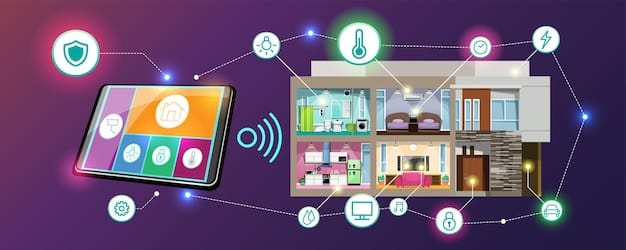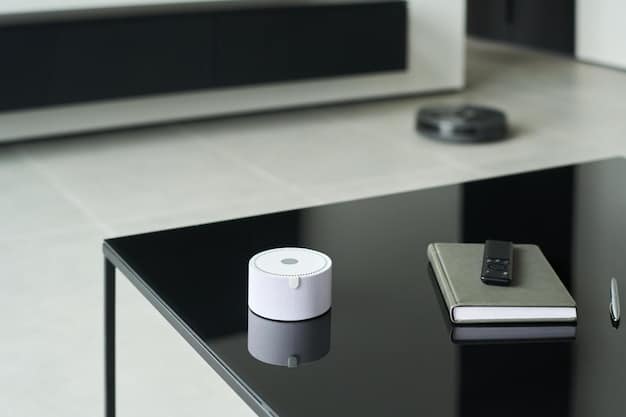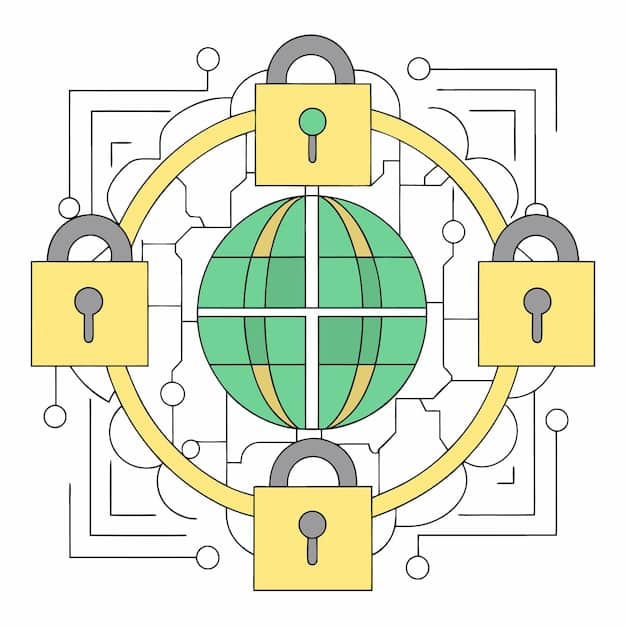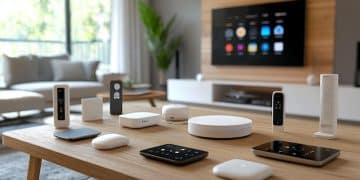IoT Privacy: Securing Your Smart Home in the Digital Age

The Internet of Things (IoT) and Your Privacy: Securing Your Smart Home involves understanding the risks associated with interconnected devices and implementing effective measures such as strong passwords, regular software updates, and network segmentation to protect personal data from unauthorized access and cyber threats.
In today’s connected world, the Internet of Things (IoT) and Your Privacy: Securing Your Smart Home is more important than ever. With an increasing number of devices integrated into our daily lives, from smart thermostats to security cameras, understanding the potential privacy risks and how to mitigate them is crucial.
Understanding the IoT Landscape and Privacy Concerns
The Internet of Things (IoT) has transformed the way we live, offering convenience and automation through interconnected devices. However, this connectivity also introduces significant privacy concerns. It’s essential to understand the basics of IoT and the potential risks it poses to your personal information.
What is the Internet of Things (IoT)?
The Internet of Things refers to the network of physical devices, vehicles, home appliances, and other items embedded with electronics, software, sensors, and network connectivity that enables these objects to collect and exchange data. These devices can communicate with each other and with central servers, often without direct human intervention.
Common IoT Devices in Smart Homes
Smart homes are filled with IoT devices designed to enhance convenience and efficiency. Some common examples include:
- Smart Speakers (e.g., Amazon Echo, Google Home): These devices listen for voice commands, recording and storing audio data.
- Smart Thermostats (e.g., Nest, Ecobee): These devices monitor and adjust temperature settings, collecting data on your home’s heating and cooling patterns.
- Security Cameras (e.g., Ring, Arlo): These devices record video and audio, often storing footage in the cloud.
- Smart TVs: These devices collect data on your viewing habits and can even listen to your conversations.

In conclusion, understanding the IoT landscape and the devices within it is the first step in addressing privacy concerns. Recognizing the types of data these devices collect and how they are interconnected is crucial for implementing effective security measures.
Potential Privacy Risks Associated with IoT Devices
IoT devices, while convenient, present various privacy risks that users should be aware of. Understanding these risks is crucial for taking proactive steps to protect your personal information.
Data Collection and Usage by IoT Devices
IoT devices collect vast amounts of data, including:
- Personal Information: Names, addresses, email addresses, and phone numbers.
- Usage Data: Information on how you use the devices, such as the times you turn lights on and off or the programs you watch on your smart TV.
- Location Data: Data on your whereabouts, collected through devices like smartwatches or location-enabled smart home devices.
How IoT Data is Stored and Shared
Data collected by IoT devices is often stored in the cloud, where it can be vulnerable to breaches and unauthorized access. This data is also frequently shared with third parties, including advertisers, data brokers, and other companies, often without your explicit consent.
Real-World Examples of IoT Privacy Breaches
Several high-profile privacy breaches have highlighted the risks associated with IoT devices:
For example, in 2016, the Mirai botnet used compromised IoT devices, like security cameras and routers, to launch a massive DDoS attack, demonstrating the vulnerability of these devices to cyber threats. There are also cases of smart TVs recording users’ conversations without their knowledge, raising serious privacy concerns. And, a Baby monitors have been hacked, allowing unauthorized individuals to spy on families.
In summary, understanding the potential privacy risks associated with IoT devices, including data collection, storage practices, and real-world examples of breaches, is essential for making informed decisions and implementing effective security measures.
Essential Security Measures for Securing Your Smart Home
Securing your smart home requires implementing a range of security measures to protect your devices and personal data. These measures can significantly reduce the risk of unauthorized access and privacy breaches.

Strengthening Passwords and Authentication
One of the most basic yet critical security measures is using strong, unique passwords for all your IoT devices. Default passwords are easy targets for hackers, so it is essential to change them immediately upon setting up a new device. Consider using a password manager to generate and store complex passwords securely.
Keeping Software Updated
Regular software updates are essential for patching security vulnerabilities and keeping your devices protected against the latest threats. Many IoT devices offer automatic update features, which you should enable to ensure your devices are always running the latest security patches.
Securing Your Home Wi-Fi Network
Your home Wi-Fi network is the gateway to all your IoT devices, so securing it is crucial. Use a strong password for your Wi-Fi network and enable WPA3 encryption, which offers enhanced security compared to older protocols like WPA2. Additionally, consider disabling WPS (Wi-Fi Protected Setup), which can be vulnerable to attacks.
In short, Implementing these security measures – strengthening passwords, keeping software updated, and securing your home Wi-Fi network – can significantly enhance the security of your smart home and protect your privacy.
Advanced Techniques for Enhancing IoT Privacy
In addition to basic security measures, several advanced techniques can further enhance your IoT privacy. These techniques provide additional layers of protection against unauthorized access and data breaches.
Network Segmentation
Network segmentation involves dividing your home network into separate zones, isolating your IoT devices from your computers and other sensitive devices. This can be achieved using a router with VLAN (Virtual LAN) support or by creating a separate guest network for your IoT devices. By isolating your IoT devices, you can prevent hackers from accessing your sensitive data if one of your IoT devices is compromised.
Using a VPN (Virtual Private Network)
A VPN encrypts your internet traffic and masks your IP address, making it more difficult for hackers to intercept your data. While VPNs are commonly used on computers and mobile devices, you can also configure your router to use a VPN, protecting all devices on your network, including your IoT devices.
Monitoring Network Traffic
Monitoring your network traffic can help you detect suspicious activity and identify potential security breaches. There are several tools available that can monitor your network traffic and alert you to any unusual behavior, such as unauthorized devices connecting to your network or excessive data usage by a particular device.
Implementing Two-Factor Authentication (2FA)
Enabling 2FA adds an extra layer of security to your accounts by requiring a second form of verification, such as a code sent to your phone, in addition to your password. While not all IoT devices support 2FA, enabling it on accounts associated with your IoT devices, such as your smart home platform account, can significantly enhance your security.
In summary, advanced techniques like network segmentation, using a VPN, monitoring network traffic, and implementing two-factor authentication can provide additional layers of protection for your IoT devices and enhance your overall privacy.
Understanding Privacy Policies and Data Sharing Practices
Privacy policies and data sharing practices are crucial aspects of IoT security. Understanding these elements helps you make informed decisions about the devices you use and the data you share with companies.
Analyzing IoT Device Privacy Policies
Before purchasing and using an IoT device, carefully review its privacy policy. Pay attention to the types of data the device collects, how the data is stored, and with whom the data is shared. Look for clear and concise language, and be wary of policies that are vague or overly broad. Understanding this is an important element of using The Internet of Things (IoT) and Your Privacy: Securing Your Smart Home
Opting Out of Data Collection and Sharing
Many IoT devices offer options to opt out of data collection and sharing. Take the time to explore these options and disable any features that you are not comfortable with. Keep an eye out for settings related to personalized advertising, usage tracking, and data sharing with third parties.
Understanding Third-Party Data Sharing Agreements
IoT device manufacturers often partner with third-party companies to provide additional services or features. These partnerships may involve sharing your data with these third parties. Make sure you understand the data sharing agreements and privacy policies of these third parties as well.
In a word, a thorough understanding of privacy policies, opting out of unnecessary data collection, and scrutinizing third-party agreements are essential steps in maintaining your privacy when using IoT devices.
Best Practices for Maintaining Long-Term IoT Privacy
Maintaining long-term IoT privacy requires ongoing vigilance and proactive measures. By following these best practices, you can continue to protect your personal information as the IoT landscape evolves.
Regularly Reviewing and Updating Security Settings
Make it a habit to regularly review and update the security settings on your IoT devices. Check for new security features, privacy options, and update your passwords periodically. Stay informed about evolving threats and vulnerabilities and adjust your security settings accordingly.
Staying Informed About Emerging IoT Threats
The IoT landscape is constantly evolving, with new threats and vulnerabilities emerging regularly. Stay informed about the latest security news, advisories, and best practices by following reputable security blogs, news outlets, and industry experts. This knowledge will help you proactively address potential risks and protect your devices.
- Follow security blogs and news outlets.
- Participate in online forums and communities.
- Attend security conferences and webinars.
Replacing Obsolete Devices
As IoT devices age, they may become more vulnerable to security threats due to outdated software and lack of security updates. Consider replacing obsolete devices with newer models that offer enhanced security features. Before disposing of old devices, make sure to securely wipe any personal data stored on them.
In conclusion, maintaining long-term IoT privacy requires ongoing vigilance, regular security updates, staying informed about emerging threats, and replacing obsolete devices. By following these best practices, you can continue to protect your personal information in the ever-evolving IoT landscape.
| Key Point | Brief Description |
|---|---|
| 🔑 Strong Passwords | Use unique, complex passwords for each IoT device to prevent unauthorized access. |
| 🔄 Software Updates | Regularly update IoT device software to patch security vulnerabilities. |
| 🌐 Network Segmentation | Isolate IoT devices on a separate network to limit potential damage from breaches. |
| 🛡️ Privacy Policies | Review privacy policies to understand data collection and sharing practices. |
▼
IoT devices are physical objects embedded with sensors, software, and other technologies for connecting and exchanging data with other devices and systems over the internet.
▼
IoT privacy is important because these devices collect vast amounts of personal data, which, if compromised, can lead to identity theft, financial loss, and other privacy violations.
▼
You can secure your smart home by using strong passwords, keeping software updated, segmenting your network, and regularly reviewing privacy policies of your IoT devices.
▼
Network segmentation divides your home network into separate zones, isolating IoT devices from computers and other sensitive devices to prevent widespread damage from a potential breach.
▼
Yes, reviewing privacy policies regularly helps you understand how your data is being collected and used, allowing you to make informed decisions about your IoT devices.
Conclusion
Securing your smart home in the age of the Internet of Things requires a comprehensive approach. By understanding the potential privacy risks, implementing essential security measures, and adopting advanced techniques, you can protect your personal information and enjoy the benefits of a connected lifestyle without compromising your privacy.





